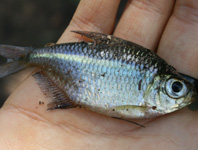Abstract
A new species of Moenkhausia is described from the upper rio Tocantins basin, States of Goiás and Tocantins, Brazil. Moenkhausia goya, new species, can be distinguished from its congeners by the shape of the humeral blotch in combination with a uniform dark pigmentation covering the interradial membranes of the dorsal and anal fins. Among congeners, the new species is most similar to M. britskii Azevedo-Santos & Benine, M. grandisquamis (Müller & Troschel) and M. xinguensis Steindachner by presenting a deep body, a large, round humeral blotch and fins without discrete patches of dark pigmentation (i.e., without well-defined blotches or stripes). With the description of M. goya, the number of species endemic to the upper rio Tocantins basin (considered upstream from the mouth of the rio Paranã) is raised to 51. Of these, some are widespread in the upper rio Tocantins basin, while others seem to be restricted to one of its sub-basins.
References
Albert, J.S., Petry, P. & Reis, R.E. (2011) Major biogeographic and phylogenetic patterns. In: Albert, J.S. & Reis, R.E. (Eds.), Historical biogeography of Neotropical freshwater fishes. University of California Press, Los Angeles, pp. 21–57.
Azevedo-Santos, V.M. & Benine, R.C. (2016) A new species of Moenkhausia (Characiformes, Characidae) from the Içá River, Amazon Basin, northern Brazil. Zoosystematics and Evolution, 92 (2), 203–209.
https://doi.org/10.3897/zse.92.10049Benine, R.C. (2004) Análise filogenética do gênero Moenkhausia Eigenmann, 1903 (Characiformes: Characidae) com uma revisão dos táxons do alto rio Paraná. Unpublished Doctoral Thesis, Universidade Estadual Paulista, Botucatu, 317 pp.
Benine, R.C., Mariguela, T.C. & Oliveira, C. (2009) New species of Moenkhausia Eigenmann, 1903 (Characiformes: Characidae) with comments on the Moenkhausia oligolepis species complex. Neotropical Ichthyology, 7 (2), 161–168.
https://doi.org/10.1590/s1679-62252009000200005Bertaco, V.A. & Carvalho, F.R. (2010) New species of Hasemania (Characiformes: Characidae) from central Brazil, with comments on the endemism of upper Tocantins basin, Goiás State. Neotropical Ichthyology, 8 (1), 27–32.
https://doi.org/10.1590/s1679-62252010000100004Bertaco, V.A., Jerep, F.C. & Carvalho, F.R. (2011) New species of Moenkhausia Eigenmann (Ostariophysi: Characidae) from the upper rio Tocantins basin in Central Brazil. Neotropical Ichthyology, 9 (1), 57–63.
https://doi.org/10.1590/s1679-62252011000100003Dagosta, F.C.P. & Marinho, M.M.F. (2016) A new species of Moenkhausia Eigenmann (Characiformes: Characidae) from the rio Arinos basin, Brazil. Neotropical Ichthyology, 14 (2), 289–296.
https://doi.org/10.1590/1982-0224-20150052Dagosta, F.C.P., Marinho, M.M.F. & Benine, R.C. (2015) A new species of Moenkhausia Eigenmann (Characiformes: Characidae) from the upper rio Juruena basin, Central Brazil. Zootaxa, 4032 (4), 417–425.
https://doi.org/10.11646/zootaxa.4032.4.6Dagosta, F.C.P & de Pinna, M. (2017) Biogeography of Amazonian fishes: deconstructing river basins as biogeographic units. Neotropical Ichthyology, 15 (3).
https://dx.doi.org/10.1590/1982-0224-20170034Eigenmann, C.H. (1903) New genera of South American fresh-water fishes, and new names for some old genera. Smithsonian Miscellaneous Collections, 45 (1), 144–148.
Eigenmann, C.H. (1917) The American Characidae. Part I. Memoirs of the Museum of Comparative Zoölogy at Harvard College, 43 (1), 1–102, 16 pls.
Fink, W.L. (1979) A new species of Moenkhausia from the Mato Grosso region of Brazil (Pisces: Characidae). Breviora, 450, 1–12.
Fink, W.L. & Weitzman S.H. (1974) The so-called cheirodontin fishes of Central America with descriptions of two new species (Pisces: Characidae). Smithsonian Contributions to Zoology, 172, 1–46.
https://doi.org/10.5479/si.00810282.172Géry, J. (1965) Notes on characoid fishes collected in Surinam by Mr. H. P. Pijpers, with descriptions of new forms. Bijdragen tot de Dierkunde, 35, 101–126.
IUCN Standards and Petitions Subcommittee (2017) Guidelines for using the IUCN Red List Categories and Criteria. Version 13. Available from: http://nc.iucnredlist.org/redlist/content/attachment_files/RedListGuidelines.pdf (accessed 16 October 2018)
Mariguela, T.C., Benine, R.C., Abe, K.T., Avelino, G.S. & Oliveira, C. (2013) Molecular phylogeny of Moenkhausia (Characidae) inferred from mitochondrial and nuclear DNA evidence. Journal of Zoological Systematics and Evolutionary Research, 51 (4), 327–332.
https://doi.org/10.1111/jzs.12025Marinho, M.M.F. (2010) A new species of Moenkhausia Eigenmann (Characiformes: Characidae) from the rio Xingu basin, Brazil. Neotropical Ichthyology, 8 (3), 655–659.
https://doi.org/10.1590/s1679-62252010000300011Mirande, J.M. (2018) Morphology, molecules and the phylogeny of Characidae (Teleostei, Characiformes). Cladistics. [published onine]
https://doi.org/10.1111/cla.12345Ohara, W.M. & Lima, F.C.T. (2015) Moenkhausia uirapuru, a new species from the rio Guaporé, Chapada dos Parecis, Mato Grosso, Brazil (Teleostei, Characidae). Ichthyological Exploration of Freshwaters, 26 (2), 159–170.
Ohara, W.M. & Marinho, M.M.F. (2016) A new species of Moenkhausia Eigenmann (Characiformes: Characidae) from the upper rio Machado at Chapada dos Parecis, rio Madeira basin, Brazil. Neotropical Ichthyology, 14 (1), 37–44.
https://doi.org/10.1590/1982-0224-20150041Ota, R.P., Lima, F.C.T. & Pavanelli, C.S. (2014) A new species of Hemigrammus Gill, 1858 (Characiformes: Characidae) from the rio Madeira and rio Paraguai basins, with a redescription of H. lunatus. Neotropical Ichthyology, 12 (2), 265–279.
https://doi.org/10.1590/1982-0224-20130176Pastana, M.N.L. & Dagosta, F.C.P. (2014) Moenkhausia rubra, a new species from rio Juruena, upper rio Tapajós basin, Brazil (Characiformes: Characidae). Neotropical Ichthyology, 12 (2), 389–396.
https://doi.org/10.1590/1982-0224-20130183Petrolli, M.G., Azevedo-Santos, V.M. & Benine, R.C. (2016) Moenkhausia venerei (Characiformes: Characidae), a new species from the rio Araguaia, Central Brazil. Zootaxa, 4105 (2), 159–170.
https://doi.org/10.11646/zootaxa.4105.2.4Ribeiro, M.C.L.B., Petrere Júnior, M. & Juras, A.A. (1995) Ecological integrity and fisheries ecology of the Araguaia-Tocantins river basin, Brazil. Regulated Rivers: Research and Management, 11 (3 & 4), 325–350.
Sabaj, M.H. (2016) Standard symbolic codes for institution resource collections in herpetology and ichthyology: an online reference. Version 6.5. American Society of Ichthyologists and Herpetologists, Washington, D.C. Available from: http://www.asih.org/sites/default/files/documents/symbolic_codes_for_collections_v6.5_2016.pdf (accessed 16 August 2016)
Sousa, L.M., Netto-Ferreira, A.L. & Birindelli, J.L.O. (2010) Two new species of Moenkhausia Eigenmann (Characiformes: Characidae) from Serra do Cachimbo, Pará, northern Brazil. Neotropical Ichthyology, 8 (2), 255–264.
https://doi.org/10.1590/s1679-62252010000200003Taylor, W.R. & Van Dyke, G.C. (1985) Revised procedures for staining and clearing small fishes and other vertebrates for bone and cartilage study. Cybium, 9 (2), 107–119.
Zawadzki, C.H. & Carvalho, P.H. (2014) A new species of the Hypostomus cochliodon group (Siluriformes: Loricariidae) from the rio Aripuanã basin in Brazil. Neotropical Ichthyology, 12 (1), 43–51.
https://doi.org/10.1590/s1679-62252014000100004

